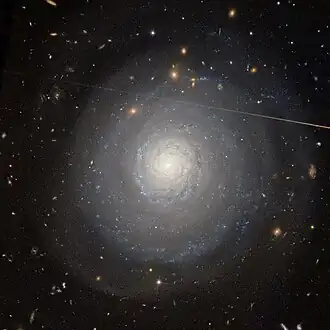MCG +07-33-027
| MCG +07-33-027 | |
|---|---|
 Starburst galaxy MCG +07-33-027 imaged by the Hubble Space Telescope. | |
| Observation data (J2000 epoch) | |
| Constellation | Hercules |
| Right ascension | 16h 02m 16.6s[1] |
| Declination | 42° 55′ 01″[1] |
| Redshift | 0.024486/7341 km/s[1] |
| Distance | 329,462,000 ly |
| Apparent magnitude (V) | 14.5 |
| Characteristics | |
| Type | Sa[1] |
| Size | ~104,057.8 ly (estimated)[1] |
| Apparent size (V) | 0.86' x 0.74[1] |
| Other designations | |
| PGC 56779[1] | |
MCG +07-33-027 is an isolated spiral galaxy[2] located about 330 million light-years away[3] in the constellation Hercules.[4] It has a very high rate of star formation which would make it a starburst galaxy. Normally, starburst galaxies are triggered by the collision of another galaxy. However most galaxies are in groups or clusters, while MCG +07-33-027 is solitary. Therefore, the cause of the starburst was not due to a collision or by the passing of a nearby galaxy and so the cause of the activity remains unknown.[2]
Supernova
One supernova has been observed in MCG +07-33-027.
- SN 2005bk (type Ic, mag. 18) was discovered by R. A. Jansen, K. Tamura, and N. A. Grogin on April 2, 2005.[5][6]
See also
References
- ^ a b c d e f g "NASA/IPAC Extragalactic Database". Results for MCG +07-33-027. Retrieved 2017-07-26.
- ^ a b "A lonely birthplace". www.spacetelescope.org. Retrieved 2017-07-27.
- ^ "Your NED Search Results". ned.ipac.caltech.edu. Retrieved 2017-07-27.
- ^ "Principal Galaxy Catalog (PGC) Objects 56500 to 56999". cseligman.com. Retrieved 2017-07-27.
- ^ Jansen, R. A.; Tamura, K.; Grogin, N. A. (2005). "Supernova 2005bk in MCG +07-33-27". International Astronomical Union Circular (8512): 1. Bibcode:2005IAUC.8512....1J.
- ^ "SN 2005bk". Transient Name Server. IAU. Retrieved 25 July 2025.
External links
- MCG +07-33-027 on WikiSky: DSS2, SDSS, GALEX, IRAS, Hydrogen α, X-Ray, Astrophoto, Sky Map, Articles and images